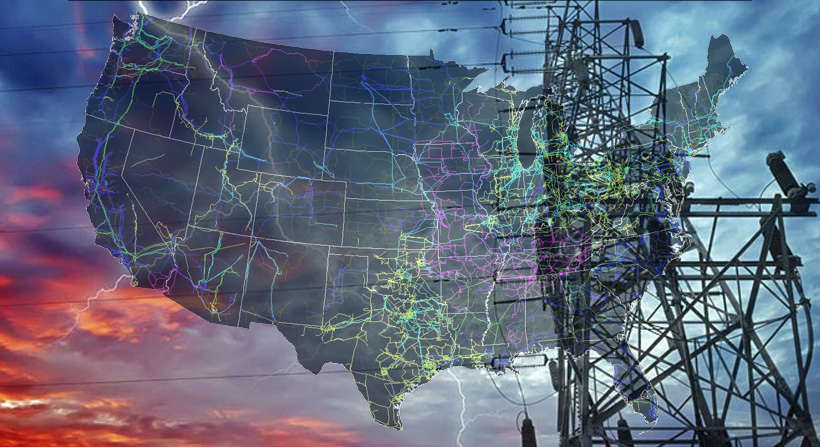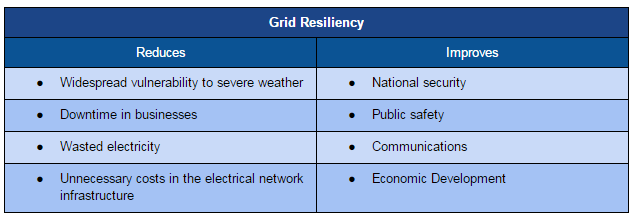
Solving Grid Resiliency Problems Using an Innovation in Computing
Grid Resiliency
When dissecting the concept of grid resiliency, it is clear that the grid is an amassment of smaller independent electrical networks which are somewhat unstable, frequently demonstrating disruption of service which can be as simple as a flicker or as consequential as a loss of power. The interconnection of precarious electrical networks increases both the complexity and instability of the overall grid and decreases the overall resiliency of the grid.
In today’s grid, a tree branch can cause a disturbance and cascade in size to put millions of people without power in a matter of minutes. With the world experiencing more extreme and unpredictable weather patterns, this vulnerability is simply unacceptable, particularly when the economic impact from weather related power outages hovers between $18 billion and $33 billion annually.
We cannot talk about grid resiliency without discussing electrical network resiliency at the home and business level. Solving instability at this level will multiply in its effect and automatically deliver grid resiliency that will save the entire value chain money and energy. Most importantly, it will harden our grid by providing distributed stability in our homes and businesses and industrial facilities which is the foundation of a resilient grid.
Defining Resiliency
For the purposes of clarity, grid resiliency can be broken down into two categories: recovery resiliency and live resiliency.
Recovery resiliency is how quickly a power disruption is amended and the electrical networks begin to receive steady, stable power again. The recovery time can be shortened with redundancy and grid level storage as well as implementing sophisticated grid level distribution infrastructure.
An important consideration is the recovery time only includes the restoration of power to the networks and does not incorporate the time it takes for the businesses to restart operations. For business operations, this startup time varies and is still considered downtime, lost revenue and higher expenses.
Live resiliency is how well electrical networks adjust in response to the instantaneous shifts in supply and demand of electricity to prevent power disruption from occurring.
Distributing electricity is not so simple as connecting a power source and a load. There are scores of factors to consider from maintaining a consistent voltage, to balancing phases and reducing losses all while observing the required codes and regulations in order to maintain a safe environment. Power outages occur when one of these factors becomes unmanageable and the electrical network cannot adjust quickly enough. The elasticity of the network to absorb or correct for that required adjustment in real time to prevent it from cascading out of control and causing a power outage is considered live resiliency.
With a successful live resiliency strategy, there will be less recovery needed because the grid will experience fewer power outages. This is an important concept because the United States is overly dependent on electricity, from communications to food and water supply. Simply put, grid resiliency is a national security issue.

There is Something Missing in Our Grid
Given the lack of resiliency throughout our grid, it is reasonable to consider that we have either built the grid incorrectly or that there are missing components that render our grid incomplete. Efficiencies can certainly be gained from modern grid and microgrid designs and layouts which can improve resiliency, however the grid component makeup is the same, so the improvement possibility is limited.
One very important consideration to understand is that every facet of our modern grid and all of the metering and power electronics measure electricity using analog methodologies. There has yet to be a breakthrough on the digital measurement of real time electricity flow. It stands to reason that there must be a limit on our ability to precisely generate, transmit, distribute, store and consume electricity using analog methodologies.
Consider that there is a lot of heat that exists throughout the entire grid involved in the generation, transmission, distribution, storing and consumption electricity. In fact, heat is one of the only things that is distributed as equally across our grid as instability. Is it possible that heat, instability and the fact that we do not precisely measure electricity are interconnected?
Approaching Grid Resiliency Using the Power of Computing
3DFS recognized that an industry changing opportunity was on the table, to transform the way that electricity is measured from analog to digital. Solving this challenge would potentially force a transition in the way that humans use electricity, from a brute force mechanical, high power, low visibility Neanderthal electrical grid to a truly resilient, low power, high visibility Smart Grid.
3DFS took a novel approach to electrical network resiliency by applying the power of computing. Precision digital measurement of electricity generates enormous amounts of streaming data at the nanosecond level. Processing that amount of data at that speed has the potential to generate a lot of heat if traditional linear computing is used. In fact, these speeds require a solution that exceeds the capacity of matrix computing.
The ability to process this amount of data required the invention of a new computing methodology; an innovative way to process tremendous amounts of streaming granular data without generating heat.
We have coined our methodology Conveyor Matrix Computing and it is immensely powerful. The uninterrupted processing of streaming electrical usage data at such a high fidelity creates robust real time visibility in electrical networks. For the first time, technology can provide us with digital eyes in our grid to be fully aware of everything occurring in the electrical network.
Resiliency Requires More Than Visibility
Better measurement of electricity is remarkable because it allows us to observe and record the quantity and quality of electrical distortions present. But supreme measurement does not improve resiliency. For that there needs to be some form of interaction with the electricity. The most significant technological feat of 3DFS technology does not lie in the ability to measure the real time multi-parametric signature of electricity, but rather to use those measurements to calculate how to correct the distortions that are present.
Leveraging the processing power, 3DFS technology uses the foundation of streaming nanosecond level data points to calculate precise injections and extractions of current at the microsecond level that counter the existing distortions. No longer will electrical network or grid events cascade out of control, rather they are dynamically managed at the microsecond level by a live response computing system. This is a new principle of controlling electricity and the result is live resiliency in any electrical network which collectively will deliver grid level resiliency.
Innovative Emerging Technology Will Change Our Energy Future
3DFS is a small, emerging energy tech company with a transformative technology that can essentially be scaled, adapted and modified to any electrical environment with the same result. Electrical network resiliency will improve revenues and decrease expenditures, guaranteed.
This method for controlling electricity is harnessed in the most exquisite technology that can easily leverage a market based approach that will decidedly advance and quickly exceed the world’s energy and carbon reduction goals.
As a small company, we urge the world to learn more about how live resiliency can be maintained by our innovative computing system, saving money, time and headaches.


